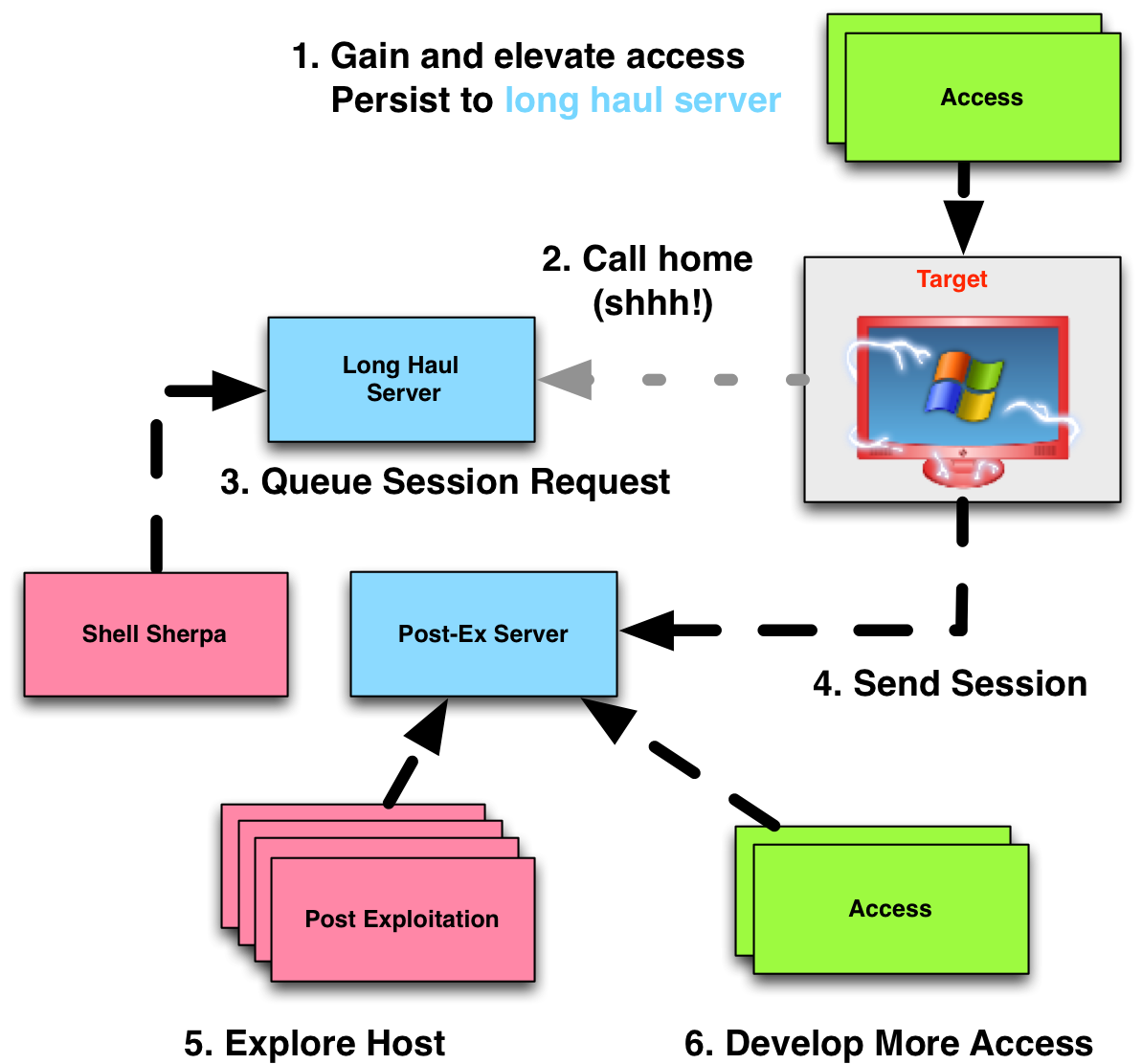I often get asked about red team skills and training. What should each team member know how to do? For exercises or long running attack simulations, I believe it’s fruitful to put junior members into the post-exploitation role first. This post describes the post-exploitation team, where they fit into the overall engagement, and their core tasks and skills.
Context
Before we dig into the post-exploitation team, let’s go big picture for a moment. The following diagram is from my 2012 Dirty Red Team Tricks II talk at DerbyCon. It shows the model for hand-off from persistent access to post-exploitation that I saw evolve during the 2011 and 2012 CCDC seasons.

This diagram isn’t far off from the infrastructure and access hand-off model that I recommend today. The main difference is that I recommend the use of staging servers. These servers act as an intermediary between the servers for long-haul persistence and interactive post-exploitation.
The workflow from the above diagram is still the same.
Getting to Post Exploitation
An access team works to get a foothold into a target network. There’s a lot that goes into getting a foothold–especially when it’s important to not get caught.
The next step is to escalate privileges on the network, ideally to domain administrator. Domain administrator is not always required to accomplish a specific goal. It’s a stepping stone to easily accomplish a goal on a network.
It’s important to also setup persistent payloads through the network so that the red team may regain a foothold, with privileges. These payloads should call home to the long-haul infrastructure.
These steps to get a foothold, elevate access, and execute a persistence plan are (potentially) hard. These steps depend on the target environment and may require custom code to succeed. You want your strongest people available for these tasks.
Post Exploitation
As sexy as it is to break in, take the terrain, and hold it, no one breaks into networks and holds them for no anticipated purpose. It’s important to have objectives. Depending on the engagement, these objectives may mirror those a likely adversary would go after or they should satisfy training criteria for a network defense team.
Conducting post-exploitation activity and working on objectives is something well-trained, but potentially junior, red team members can do.
What should the post-exploitation team know how to do? What are their core skills? These team members should know how to task an asynchronous agent into interactive access. I arbitrarily define interactive access as a payload that calls home on a one minute interval or faster.
Interactive control should always happen on infrastructure that is separate from the infrastructure used to receive low and slow callbacks. This helps protect the red team’s operational security. If an interactive access gets caught, you do not want to lose all of your persisted access because of it. Ideally, the tool for interactive access is different from the tool for low and slow access [or, at least, different indicators!].
Once a team member has access to a system, they have to work from that access. They must know how to navigate a file system, download files, log keystrokes, take screenshots, hijack browser sessions, and otherwise grab whatever satisfies the objective they’re out to meet. They should also know how to interpret the output from each of these tasks and act on this information. They must also know how to triage sources of information and find what’s interesting, quickly.
Team members should know lateral movement, cold. They must know how to work with credentials, tokens, and Kerberos tickets. They should know their options to touch other systems with these things. If they need to use a payload (NOT always the right answer); they should know how to bootstrap the payload with PowerShell when it’s possible. If they have to fall back to an executable, they should know how to generate an anti-virus safe artifact.
Concretely, I expect post-exploitation team members to know how to start a remote process with psexec, at, schtasks, wmic, and sc. This skill also requires the team member to understand the nuances of which artifacts they can and can’t use with each of these. For example, if I try to schedule a plain executable with sc it will fail. Why? Because sc expects an executable that responds to Service Control Manager messages. If I schedule an executable that doesn’t do this, Windows will kill it very quickly.
All red team members should have judgement. They should know that the direct route isn’t always the best way to fulfill a requirement.
Team members should understand that some post-exploitation actions will fail depending on several contextual factors. Troubleshooting these contextual factors comes with experience. It’s helpful to have a senior lead on hand to step in when a junior member gets stuck.
All red team members should know how to tunnel external tools through any interactive post-exploitation tools in use. SOCKS and proxychains are good topics of study. All red team members should also have strong knowledge of the standard clients that interact with common services.
Finally, red team members should know how to clean up after themselves. If they’re done with an interactive access, they should know to drop it.
These core skills cover most of the work a post-exploitation team will do. Train several junior members with these skills, assign them to a senior lead, and you’ll get a lot of use out of them. They’ll grow during the engagement too.
Tradecraft, parts 4 through 9, covers these topics.